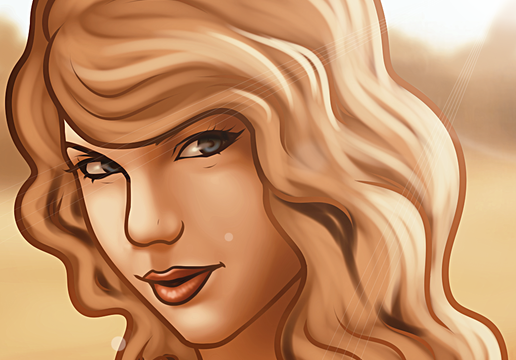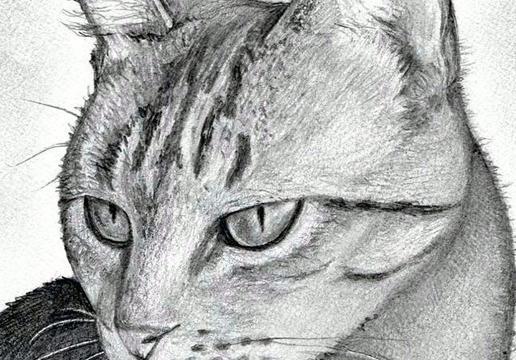How to Draw a Realistic Lynx
1
Sketch the circle for the lynx's head. Lightly draw this with a No.2 or HB pencil. You can use a lid, compass, CD... or just freehand.
3
Looks like alien, right? *giggle* Go ahead and draw red diagonal lines for ears and the cup shape for the muzzle.
6
Observe where the wildcat's features appear in relation to the guidelines. Draw in its muzzle, whiskers, and markings.
7
Watch closely how the lynx's head and the inside of its ears, and the black hair tuft at the tip of the ears relate to the guidelines. As you draw, you will have more accuracy.
8
When you sketch his hair on the left side facing you, add those straight lines and with a slight curve. Try staying close to the lines that represent the direction of the fur. This will help as you shade it in.
9
Now draw in his the right side of the lynx's fur. If you haven't already, you can erase your guidelines.
10
I made this line drawing especially for you if you don't want to do the pencil shading and blending part. Otherwise, let us continue to the pencil drawing part.
11
Here is the outline done with a 0.7mm mechanical pencil. Look closely and see if your lines look something like this. You can erase if certain areas like the eyes or nose don't line up. Take you kneaded eraser and dab off the shadow outlines or dark
12
This time Acrylics has won! Sandpaper, the new kid on the block has to take a back seat to my wonderful Titanium White or Opaque White Watercolors for HIGHLIGHTS! Yaaaa! Try it, you'll like it!
13
The picture that goes with this step shows two different ways to hold your pencil to acquire certain effects. OVERHAND: Holding a sharpened pencil in normal writing form with fingers in the middle or near the lead gives you great control and thin/det
14
PENCIL STROKES & TONE, SHADING, TEXTURE -- For your convenience, I have inserted this step with different pencils, strokes to use. And you can study the shapes that make up this drawing universe, along with tone, shading, and texture.
15
If it weren't for Finalprodigy, I don't think I would've done as well. His words really helped me to finish this product with satisfaction: "As a rule of thumb, body fur flows away from the head. Make sure that you are drawing in those long light ha
16
The picture here is a great exercise for value shading. I've got a little secret tip for you to make things easier. You can download this to your desktop. First click on the picture to have access to full size. By right clicking on your mouse, you ca
17
After printing out a number of the above template, practice shading in the values like this picture. You become familiar with this shading technique that gives you more control and confidence.
18
I have never done a wildcat of this magnitude before. I was like, "What do I do with all that fur." I resorted to sketching in the details with my 0.7mm HB trusty mechanical pencil. And for the beginning of this sketch, I applied direction arrows of
19
Now that the midsection from his nose up is done. I've made short individual strokes for the cat's hair. If you need a directional guide, go to step 15.
20
With my blending stump, I smoothed out the sketch lines and added more texture lines to his fur with my 0.7mm mechanical. Also I took my kneaded eraser and made white line definitions for the whiskers and hair within its ears.
21
This is the first start with the pastel application. In a few strokes I've got area coverage. Applied medium gray to face. Medium dark gray to hair. I used my blending stump to "draw" in more small lines, add more shading the face. I need to whiten
22
I have to say this...OH, I'M GLAD I'M FINISHED... how about you? This was one heck of a learning experience. The fur details came out because I added more shading with my pastels and darkened the background. I took white acrylic and added highlights
23
Without highlights, your picture would have a flat appearance. Click on this picture to learn how to make your own picture POP out!
Comments 0
Details
July 20, 2012
Description: This exotic wildcat, the lynx, ranges from gorgeous to scary. It reminds me of an over-sized domestic cat with a hefty mane and body. There are four major species, Eurasian Lynx, Canada Lynx, Iberian Lynx, (and the smallest) Bobcat. Dawn already has great information in her artist comments here: http://www.dragoart.com/tuts/8861/1/1/how-to-draw-a-lynx,-lynx.htm My tutorial is a realistic pencil approach focusing on its face. I also want to give a shout to finalprodegy for his tutorials on wildcats. I literally followed closely on how he drew fur because I never did a wildcat and short stubby fur like this. His tut is "How to Draw a Realistic Puma." I hope you learn something from this tut and please enjoy! A fav, love it or comment would be fantastic! Luv n hugs to you all and thank you!!!















































